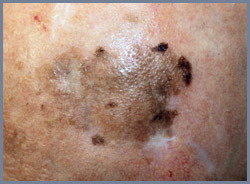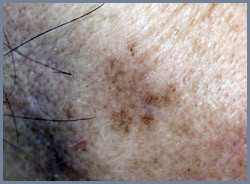 Malignant Melanoma
Malignant Melanoma
Commonly referred to as melanoma, Malignant Melanoma is a very serious form of skin cancer. Anyone can get it. When found early and treated, the cure rate is nearly 100%. But if allowed to grow, it can quickly spread to other parts of the body. And when melanoma spreads, it can be deadly. Dermatologists believe that the number of deaths from melanoma would be much lower if people:
- Knew the warning signs of melanoma.
- Learned how to examine their skin for signs of skin cancer.
- Took the time to examine their skin.
The ABCDEs of Melanoma
It’s important to take time to look at the moles on your skin because this is a good way to find melanoma early. When checking your skin, you should look for the ABCDEs of melanoma.
| A | Asymmetry | One half is unlike the other half. |
| B | Border | An irregularly scalloped or poorly defined border. |
| C | Color | The color is varied from one area to the other; has shades of tan, brown or black, or is sometimes white, red or blue. |
| D | Diameter | Melanomas usually greater than 6mm (the size of a pencil eraser) when diagnosed, but they can be smaller. |
| E | Evolving | A mole or skin lesion that looks different from the rest, or is changing in size, shape or color. |
If you see a mole or new spot on your skin that has any of the ABCDEs, immediately make an appointment to see a dermatologist.
Signs of Melanoma
The most common early signs (what you see) of melanoma are:
- Growing mole on your skin.
- Unusual looking mole on your skin or a mole that does not look like any other mole on your skin (the ugly duckling).
- Non-uniform mole (has an odd shape, uneven or uncertain border, different colors).
Symptoms of Melanoma
In the early stages, melanoma may not cause any symptoms (what you feel). But sometimes melanoma will:
- Itch
- Bleed
- Feel painful
Many melanomas have these signs and symptoms, but not all. There are actually different types of melanoma. One type can first appear as a brown or black streak underneath a fingernail or toenail. Melanoma also can look like a bruise that just won’t heal.
-
Who Gets Melanoma?
Anyone can get melanoma. Most people have light skin, but people who have brown and black skin also get melanoma. Some people have a higher risk of getting melanoma. These people have the following traits:
Skin:
— Fair skin (The risk is higher if the person also has red or blond hair and blue or green eyes.)
— Sun-sensitive skin (rarely tans but burns easily).
— 50-plus moles, large moles or unusual moles.If you have had bad sunburns or spent time tanning (sun, tanning beds, or sun lamps), you also have a higher risk of getting melanoma.
Family/Medical History
— Melanoma runs in the family (parent, child, sibling, cousin, aunt, uncle had melanoma).
— You had another skin cancer, but particularly another melanoma.
— A weakened immune system.More People Are Developing Melanoma
Few people are getting most types of cancer. Melanoma is different. More people are getting melanoma. Many are white men who are 50 years or older. More young people also are getting melanoma. Melanoma is now the most common cancer among people 25-29 year olds. Even teenagers are developing melanoma.
What Causes Melanoma?
Ultraviolet (UV) radiation is a major contributor in most cases. We get UV radiation from the sun, tanning beds, and sun lamps. Heredity also plays an important role. Research shows that if a close blood relative (parent, child, sibling, aunt, uncle) had melanoma, a person has a much greater risk of getting melanoma.
-
Finding Melanoma
Finding melanoma early is important. When melanoma is found early and treated, it is almost 100% curable. This is true even if you previously had melanoma. If melanoma spreads, it can be deadly.
Here Is What You Can Do To Find Melanoma Early:
Check your skin for signs of skin cancer. To help people find melanoma early, the American Academy of Dermatology created the body mole map, which:
— Illustrates how to examine your skin
— Shows you what to look for (ABCDEs of melanoma)
— Gives you a place to write down where your moles appear on your body.— When examining your skin, be sure to check your scalp, feet, nails, and genital area. Melanoma can appear on parts of the body that people do not think to check.
— And check your scalp, palms, soles, fingernails, and toenails. Melanoma can appear under a nail. Beneath a nail, the most common early warning sign of melanoma is a brown to black-colored nail streak.
— Another early warning sign is a spot that looks like a bruise. The bruise may fade and then come back.Make an appointment to see a dermatologist. If you find a mole or growth on your skin that is growing, unusual, bleeding or not like the rest, you should see a dermatologist.
If You Have Had Melanoma…
You should know that you have a higher (5 times higher) risk of getting another melanoma. But, there is good news. Finding melanoma early still leads to a high cure rate. You should:
Examine your skin for signs of skin cancer.
Keep all appointments for follow-up exams. The sooner melanoma or another skin cancer is found, the better the outcome. During follow-up exams, the doctors may do more than look at your skin. You may need to see an eye doctor. Melanoma can develop in the eye. You may need blood work or an x-ray.
Preventing Skin Cancer
The following can help everyone reduce their risk of getting skin cancer:
If you tan, stop! Tanning outdoors, using tanning beds, and sitting under sun lamps are not safe. Research shows indoor tanning increases a person’s melanoma risk by 75%. And, forget about getting a base tan before going on a tropical vacation. A base tan will not protect you. It just increases your risk for getting skin cancer.
Spend time outdoors when the sun is less intense. Before 10 a.m. and after 2 p.m., the sun’s rays are less intense.
Wear sunscreen every day. Even on cloudy, rainy, and snowy days, you need to wear sunscreen. Here is what to look for in a sunscreen:
— A sun protection factor (SPF) of at least 30.
— UVA and UVB protection – broad spectrumWear sunglasses that have UV protection. Melanoma can develop in the eyes.
How to Apply Sunscreen
— Apply at least 20 minutes before you go outside.
— Put sunscreen on all skin that will not be covered by clothing.
— If you spend time outside, reapply the sunscreen every 2 hours.Support Groups
If you are living with melanoma, you may want to join a support group: American Cancer Society American Melanoma Foundation Melanoma International Foundation Melanoma Research Foundation.



